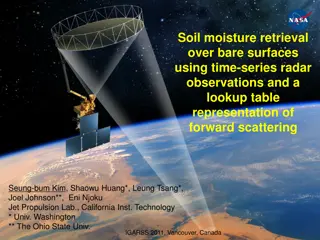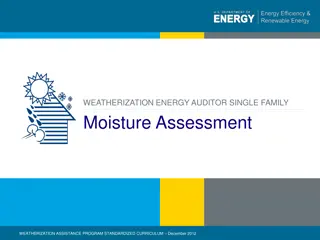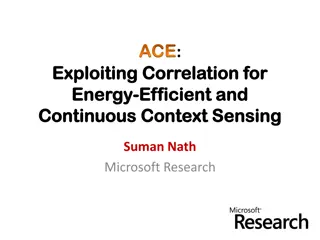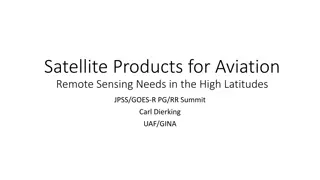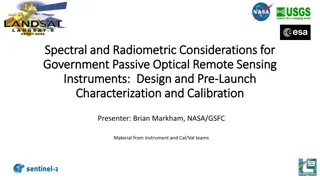Understanding Remote Sensing Sensor Resolutions & Colour Composite
Explore the art and science of remote sensing, detailing sensor types, resolution categories, and color composite techniques. Learn about the stages involved in remote sensing, sensor variations, and band designations for satellites like Landsat 8. Discover the significance of pixel, high-resolution
3 views • 13 slides
Evaluation of SPLASH and HRRR Soil Moisture Comparison
This study compares soil moisture data between the HRRR model and SPLASH observations during the 2022 warm season. It explores differences in soil moisture levels at various depths, evaluates responses to precipitation events, and drydown periods. The research focuses on analyzed data from HRRR Mode
3 views • 12 slides
Investigating Flash Droughts in Sicily Using Evapotranspiration and Soil Moisture Analysis
This study focuses on identifying flash droughts in Sicily by analyzing potential evapotranspiration and soil moisture anomalies. The research examines trends in evapotranspiration and soil moisture levels over the past 22 years, pinpointing a possible flash drought occurrence in eastern Sicily in 2
3 views • 29 slides
Latest Consensus on UWB Sensing for 802.15.4ab
Co-authors from various companies present the latest agreement on ultra-wideband (UWB) sensing topics for the IEEE 802.15.4ab standard. The consensus includes definitions for sensing pulse shape, packet formats for bi/multi-static sensing, and support for specific sequences and patterns in UWB sensi
1 views • 27 slides
Understanding Atmospheric Moisture in Physical Geography
Atmospheric moisture, in the form of water vapor, liquid water, and ice, plays a crucial role in shaping weather and climate. This course delves into the dynamics of atmospheric moisture, including its distribution, effects on weather patterns, and impact on various climatic factors such as precipit
0 views • 7 slides
Spectrum Sensing for Enhanced Channel Access in Wireless Networks
This document presents a proposal for Spectrum Sensing Based Deferral (SSBD) to improve channel access in wireless networks. SSBD incorporates spectrum sensing with transmission deferral in a time-bound manner to enhance performance, reliability, and latency control. The proposed solution safeguards
1 views • 11 slides
IEEE 802.11-21/1321r1 WLAN Sensing Procedure Proposal
This document by Solomon Trainin from Qualcomm presents a proposal on aligning the SFD for the WLAN sensing procedure. It aims to resolve contradictions, optimize behavior, and introduce a structured WLAN sensing procedure. The content outlines phases, terminology, setup, measurement, and reporting
0 views • 8 slides
IEEE 802.11-21/2011r0 Sensing NDP Announcement Overview
This document presents an overview of the IEEE 802.11-21/2011r0 Sensing NDP Announcement for utilizing NDP in sensing applications. It discusses the motivation behind NDP sensing, outlines the NDP Announcement frames, and explains possible sensing frame exchange sequences. The Ranging NDP Announceme
0 views • 8 slides
IoT Based Smart Irrigation System Project Guide
Monsoon-dependent Indian agriculture can benefit from an automatic irrigation system that prevents both over- and under-irrigation. By leveraging wireless technology, such as sensors for soil moisture, air humidity, temperature, and water levels, this project aims to optimize crop production by savi
4 views • 14 slides
IEEE 802.11-19/1769: CSI-based Wi-Fi Sensing Results & Challenges
This document from Oct. 2019 explores IEEE 802.11-19/1769 CSI-based Wi-Fi sensing, focusing on results and standardization challenges. It delves into the concept of Wi-Fi sensing, its applications in security, automation, healthcare, and more, as well as the importance of CSI parameters such as reso
0 views • 10 slides
Wi-Fi Sensing in IoT: Advantages, Use Cases, and Challenges
Wi-Fi sensing utilizes Wi-Fi devices/network to detect presence, range, angle, and velocity of passive/non-transceiver objects. This document discusses the definition, advantages, use cases like smart home applications, and challenges of Wi-Fi sensing compared to other sensing technologies. It also
6 views • 15 slides
Exploring Wi-Fi Sensing for Motion Detection and Beyond
The document discusses the utilization of Wi-Fi signals for sensing various features in a given environment, such as motion, presence, gesture, and more, without assuming the subject carries a Wi-Fi device. It covers applications, technical principles, and a three-phase algorithm for motion detectio
0 views • 24 slides
Wireless Sensing Privacy Discussions in May 2023 Document
May 2023 document (.IEEE 802..11-23-0782-00-00bf) discusses privacy issues related to wireless sensing, including unauthorized access to sensing reports, tracking of sensing devices, and potential eavesdropping on sensing signals. It proposes solutions to protect sensitive information and addresses
4 views • 12 slides
Comparison of Trigger-based vs. Non-Trigger-based Sensing Measurement in IEEE 802.11
The document discusses the differences between Trigger-based (TB) and Non-Trigger-based (Non-TB) sensing measurement instances in IEEE 802.11 standards, focusing on who initiates the sensing measurement. TB sensing is initiated by the AP, while Non-TB sensing is initiated by a non-AP STA, enabling o
6 views • 13 slides
IEEE P802.15 WPAN Sensing Device Submission
This submission to the IEEE P802.15 Working Group focuses on the development of a sensing device for Wireless Personal Area Networks (WPANs). The document discusses the integration of Ultra-Wideband (UWB) technology for sensing applications, including presence detection and environment mapping. Key
0 views • 16 slides
Exploring Wi-Fi Sensing: Feasibility and Standardization Gaps
Delve into the technical aspects of Wi-Fi sensing, discussing its definition, feasibility, and standardization gaps according to the IEEE 802.11 standard. The presentation highlights the ability of Wi-Fi systems to detect environmental changes and explores scientific publications related to Wi-Fi se
0 views • 27 slides
Wireless LAN Sensing Use Cases in Home Environments
The document discusses use cases for Wireless LAN (WLAN) sensing in home environments, focusing on the connection between multiple access points and home appliances for enhanced performance. It outlines scenarios such as gesture-controlled home appliance operation, user identification for personaliz
0 views • 11 slides
IEEE 802.11-21/0391r0: Minimizing Impact in WLAN Sensing Design
The document presents discussions on minimizing impact as a design goal within the IEEE 802.11-21/0391r0 context, emphasizing the efficiency related to the impact of sensing on network performance. It addresses the current status, constraints, design options, and thoughts regarding WLAN sensing with
1 views • 8 slides
Remote Sensing Methods for Identifying Degraded Forests in the Amazon
Using multisource remote sensing data, this study aims to identify and characterize forest degradation in the Amazonian landscape. Field work in Paragominas, Brazil, combined with optical and radar data analysis, helps in understanding carbon stocks and typology of degraded forests. The research foc
3 views • 7 slides
Understanding Hall Effect Sensors in Electronic Labs
Hall Effect sensors play a crucial role in detecting magnetic fields, enabling applications such as current sensing, rotational speed measurement in motors, and magnetic proximity sensing. They operate based on the Hall Effect phenomenon, where a magnetic field influences the flow of current in a se
2 views • 5 slides
Sparse Millimeter-Wave Imaging Using Compressed Sensing and Point Spread Function Calibration
A novel indoor millimeter-wave imaging system based on sparsity estimated compressed sensing and calibrated point spread function is introduced. The system utilizes a unique calibration procedure to process the point spread function acquired from measuring a suspended point scatterer. By estimating
2 views • 26 slides
Understanding Moisture Measurement in Sugar Processing
This content delves into the importance of moisture measurement in sugar processing, specifically focusing on the drying process. It explains how moisture percentage is crucial for various calculations and efficiency assessments in the sugar production industry. The equipment and procedures used for
0 views • 12 slides
Exploring Applications of Remote Sensing in Environmental Studies
Dr. Sanjib Pramanik, an Assistant Professor at Durga College, delves into the fascinating realm of remote sensing for environmental studies. Remote sensing allows data collection from a distance, utilizing methods like air photos and satellite imagery. The environment comprises components such as na
0 views • 35 slides
Advanced Remote Sensing Requirements and Terminology in Environmental Monitoring
Explore the latest satellite data requirements and terminology for environmental monitoring, focusing on surface soil moisture measurement, three-level climate application approach, and on-site validation reports. Gain insights into maximizing the accuracy and stability of remote sensing data for im
0 views • 6 slides
Soil Moisture Retrieval Over Bare Surfaces Using Radar Observations
This study focuses on retrieving soil moisture over bare surfaces using radar observations and a lookup table representation of forward scattering. The research aims to develop a non-empirical and simple method for accurate soil moisture retrieval without the need for ancillary information. Issues w
0 views • 14 slides
Advances in Remote Sensing for Soil Moisture Validation and Calibration
Cutting-edge methods like Cosmic-Ray Neutron Sensing (CRNS) and mobile measurements are revolutionizing soil moisture validation and calibration. From satellite-based techniques to local approaches, researchers are enhancing the accuracy and reliability of soil moisture data for various applications
0 views • 15 slides
Wireless Soil Moisture Tension Measurements for Irrigation Management
High-density, multiple-depth wireless soil moisture tension measurements were conducted in a vineyard in Napa Valley. The study found correlations between soil moisture tensions and leaf water potential, offering valuable insights for irrigation management. Utilizing a wireless sensor network, the s
0 views • 16 slides
Moisture Assessment in Weatherization Energy Auditing for Single Family Homes
This December 2012 curriculum focuses on moisture assessment in the weatherization energy auditing process for single-family homes. It covers analyzing symptoms of moisture problems, identifying sources, understanding moisture control strategies, and using assessment tools. The training aims to equi
0 views • 26 slides
Climate Models and Moisture Equilibrium in Flexible Pavement Design
Climate inputs like temperature and moisture play key roles in flexible pavement design. The heat transfer model evaluates frost action and temperature regimes, while moisture equilibrium models consider the interaction between soil suction and moisture content. Understanding these factors is crucia
0 views • 13 slides
Sugar Processing Controller Knowledge: Conditioning and Moisture Control
Understanding the importance of sugar conditioning in preventing caking during transport and storage. Factors affecting sugar conditioning efficiency include temperature, air flow, crystal size, feed sugar moisture, and more. Learn about the techniques and processes involved in sugar conditioning to
0 views • 7 slides
Evaluation of Soil Moisture Estimates from Satellite-Based Products
The study evaluates soil moisture estimates from satellite-based products over two network regions. Soil moisture is crucial for the hydrological cycle, necessitating continuous monitoring due to its spatial and temporal variability. Remote sensing is utilized to gather information without physical
0 views • 5 slides
Soil Moisture-Atmosphere Interactions in the 2003 European Summer Heat Wave
This presentation discusses the significant impacts of soil moisture-atmosphere interactions during the 2003 European Summer Heat Wave, highlighting the abnormally hot weather, pavement buckling, and high-pressure systems that contributed to the extreme conditions. The images and diagrams illustrate
0 views • 27 slides
Remote Sensing for Blue Whale Conservation: Enhancing Maritime Policy
Using remote sensing technology to monitor blue whale habitats can help address the conservation challenges posed by ship strikes. By predicting species distributions with greater precision, regulatory agencies can implement effective measures to reduce the risks faced by blue whales. Remote sensing
0 views • 18 slides
Efficient Context Sensing for Mobile Applications
Leveraging correlations between different user contexts, the ACEACE framework by Suman Nath explores energy-efficient continuous context sensing for mobile apps. By inferring expensive attributes from cheaper ones, the system optimizes sensing tasks based on human activities, significantly reducing
0 views • 23 slides
Satellite Products for Aviation Remote Sensing Needs in High Latitudes
Addressing the specific needs of aviation remote sensing in high latitudes, this content explores the importance of satellite products, variations in equipment requirements, data expectations, and the significance of cloud products for aviation safety. Feedback from aircraft operators emphasizes the
0 views • 8 slides
Spectral and Radiometric Considerations for Government Remote Sensing Instruments
This presentation explores the important considerations in designing and calibrating government passive optical remote sensing instruments, focusing on spectral and radiometric aspects. Topics include spectral variation, design considerations, uniformity, reflectance calibration, and examples from i
0 views • 27 slides
Radiometric Calibration Methods for Remote Sensing Applications
Techniques for radiometric calibration in remote sensing include vicarious approaches utilizing invariant desert sites, in-situ methods characterizing surfaces and atmospheres, and SI-traceable measurements for intercomparisons between sensors. The repeatability of in-situ results and comparison wit
0 views • 20 slides
Remote Sensing Panel Discussion: Addressing Challenges in RFI Reporting, Regulations, and Protection of Operations
The Remote Sensing panel discussion highlights key issues such as the lack of RFI reporting to the ITU, importance of RFI reporting for regulatory enforcement, obstacles in protecting remote sensing operations, desired changes in Radio Regulations, and potential discussion points for the research an
0 views • 7 slides
Enhancing Smartphone Location Sensing Efficiency
This study delves into optimizing energy consumption in smartphone location sensing mechanisms like GPS and Network Based Triangulation. Comparisons of battery drainage rates with and without GPS provide insights. Additionally, the energy efficiency of Network Based Triangulation as a less accurate
1 views • 41 slides
Constrained Adaptive Sensing and Benefits of Adaptivity
Constrained adaptive sensing involves estimating sparse signals with constraints, utilizing strategies like nonadaptive sensing and adaptive sensing. Benefits of adaptivity include reducing errors and improving estimation accuracy in signal processing. It explores the potential for improvement in re
0 views • 17 slides
























